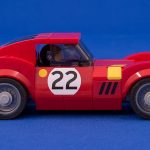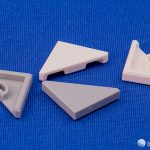The largest LEGO set in the first LEGO Speed Champions wave of 2018 is 75889 Ferrari Ultimate Garage, which includes 841 pieces and 7 minifigures. The set goes on sale for $99.99 beginning on March 1st, and LEGO sent us an early copy of the set so we could bring you this review on the day of its release.
75889 Ferrari Ultimate Garage showcases three iconic Ferrari racecars from three eras — the Ferrari 250 GTO from 1962, Ferrari 312 T4 from 1979, and current 488 GTE (the model one generation earlier than the racecar in 75886 Ferrari 488 GT3 “Scuderia Corsa”, which we reviewed earlier this week).
The box, instructions, & sticker sheets
Unlike most Speed Champions sets, 75889 Ferrari Ultimate Garage is a substantial set and comes in a correspondingly large box, similar in size to LEGO Star Wars and LEGO City sets at the $100 price point. The product photo features all three cars with the backdrop sections against a bucolic scene from Tuscany (or some other scenic Italian countryside with rolling hills and vineyards).
The back of the box features the racecars on a track (track actually not included), along with photos of the three real-life cars that inspired the LEGO models in this set.
The parts come in six numbered bags plus an unnumbered bag with several larger pieces. The three instruction booklets and two large sticker sheets (!!!) come in their own wrapper — special treatment that all large sticker sheets should get.
The pair of sticker sheets are indeed huge, with numbered stickers that go well into the 60s (and many duplicate left/right stickers).
The build
The first bag includes the parts for the 1979 Ferrari 312 T4, along with a driver. The Formula 1 racecar’s open, monocoque chassis includes modified plates with studs on the side to support the side panels, but it doesn’t use nearly as many brackets as cars with enclosed cockpits.
This set includes the new 2×2 half-tiles in white and gray — white ones are under the “12” stickers on the side of the 312 T4.
The first car’s build finishes half-way through the first instruction booklet, and includes two rear wings for varying aerodynamic needs. We’ll cover the finished model in more detail later.
The second bag includes the parts for the second car (are you sensing a pattern yet?), the vintage 1962 Ferrari 250 GTO. As you’d expect from a fully enclosed Speed Champions vehicle, the chassis incorporates brackets and headlight bricks facing out to hold the skin.
The 250 GTO also includes four new mudguards in red. These mudguards are similar to the 4 x 2 1/2 x 2 1/3 mudguard in previous Speed Champions sets, but this new mold has rounded edges that enable a curved shape in a car’s lower section.
As we can see in this comparison photo (the set includes both types of mudguards), the new rounded mudguard is also shorter.
The 250 GTO is an incredibly rounded car — taking advantage of the best in aerodynamic design of the early 1960’s. So, in addition to the rounded mudguards, the front of the car includes an upside-down car roof piece (in red for the first time).
For being so, well, red, the vintage Ferrari still has a lot of stickers. The windscreen is one that’s common in LEGO City sets, and leaves a gap between it and the rear of the passenger cabin.
Bag 3 includes the parts for the Ferrari 488 GTE, and encompasses all of the second instruction booklet. The build is effectively identical to the Ferrari 488 GT3 we reviewed a few days ago, but with some minor differences in interior bricks (presumably due to parts selection for the set as a whole) and some very minor differences that distinguish the GTE from the GT3.
We’ll take a closer look at both 488 variants later in this review, but here’s a quick comparison shot that shows how the side panels and rear wing differ slightly.
Now, I have a confession about LEGO Speed Champions sets before we continue the build past this point: I love Speed Champions cars, but as an adult LEGO builder and collector, I’m not especially interested in the various extra background pieces and racing accessories that even the smallest Speed Champions sets include. As a result, I often skip those sections of the build and just incorporate those pieces into my collection of parts for custom creations. Bags 4, 5, 6, and the unnumbered bag of large parts all build the rather substantial backdrop elements that add play and display features to this “ultimate” garage. So for all you out there reading this review looking for it to be complete, I shall build on…
The fourth bag and first part of the last instruction booklet creates a racetrack starting line arch. Notably, it incorporates two quarter-circle sections of the new rollercoaster track introduced in 70922 Joker Manor, but in light gray rather than purple. (In our opinion, this is further confirmation of the rumored Creator Rollercoaster set…) The sides of the racetrack are articulated so you can create a straight or curved section.
The last two bags include the parts for the garage itself, which includes some interesting details but doesn’t include much in the way of especially interesting building techniques, since it’s built largely from plates, panels, and tiles.
The finished model & minifigures
The three cars look pretty small next to the starting line and garage sections of the set, but they represent about half the parts in the set. The backdrop sections include many large parts, like panels and the rollercoaster segments.
The 1979 Ferrari 312 T4 includes two rear wings — a narrow one and a wider one.
The exposed rear engine has a single, centrally mounted brake light, captured accurately on the LEGO model.
The 488 GTE is decked out in SMP Racing livery — much more colorful than the mostly red Scuderia Corsa GT3.
In addition to the base red color of the Ferrari, the SMP Racing GTE has blue and yellow sections. The rear wing also has a square side profile.
I’ve complained before about stickered vs. printed canopies, and like the Scuderia Corsa 488, the GTE has a sticker applied to the transparent part.
Let’s take a closer look at the GTE in this set alongside the GT3 from 75886.
Other than the colors, the most noticeable difference is that the air dam on the front of the GTE is stickered, while the GT3 has an all-black air dam.
The side mirrors are higher on the GT3, and the brake lights on the earlier model are rounded using 1×2 rounded plates with open studs. While the black parts aren’t obvious in this photo, the rear diffuser is also built differently, with four quarter panels on the GT3, but a 1×2 “half-box” panel in the center of the diffuser achieving exactly the same shape.
The rear wing is attached on the GT3 with narrow battle droid arms, while the wing is attached with rounded robot arms on the GTE. The green, swoopy sides of the rear wing are replaced with squared-off, stickered tiles.
The vintage 250 GTO is utterly gorgeous — long and low with a monstrous hood.
I’m not sold on the studs on the hood, but I really like the asymmetrical stickering.
The minimal sponsorship stickers and large numbers really distinguish the 1962 Ferrari from its descendants, and the angled rear is reminiscent of the 1968 Ford GT40.
The starting line arch makes a great accessory to display a couple of cars together, though I strongly suspect that most builders will quickly disassemble it to get at the rollercoaster track.
The red panels on the arch are attached via a single 2×2 plate, with the sections connected via hinges. This means that the panel sections can flop around a bit, as you can see in the photo above.
The garage opens up to reveal all the detail on each side.
Trophies and vintage posters decorate the left side of the garage. If I weren’t reviewing this set, I would absolutely have saved the posters for something other than applying them in the middle of big white panels, where they’re hard to remove and will likely damage them in an attempt to do so.
The right side of the garage has a brick wall with a tool rack and a gasoline pump — though I hope it’s decorative, since pumping gas indoors seems like it would emit fumes that are hazardous to minifigure health. But since minifigures are made from petroleum, what do I know?
Curved slopes let cars drive onto the lift in the center of the garage, though the slopes could certainly use some plates under them to stabilize them and make them the same level as the rest of the garage.
A lever allows you to raise and lower the lift, though it’s not a very tall lift and those minifigure mechanics (perhaps giddy from breathing gasoline fumes) would be foolhardy to crawl underneath.
Consistent with a $100 price point, the set includes seven minifigures — three racecar drivers, two Ferrari staff, and two “plainclothes” minifigures. Like other helmeted drivers, these three drivers don’t get hair, even the female driver — unlike Christina Nielsen in the Scuderia Corsa 488.
The woman racing fan wears a great pink top with a reversible head (standard minifigure smile and sunglasses). The photographer sports a cable-knit sweater first seen in 21310 Old Fishing Store.
Conclusions & recommendation
With very rare exceptions (like the overly long 75871 Ford Mustang GT from 2016), I really enjoy building Speed Champions cars, and this set is no exception — the real stars of this set are, of course, the trio of Ferrari racecars.
Each of the cars is excellent in its own way, with varying building techniques, shaping, and overall look when it’s finished. I particularly love the vintage 1962 Ferrari.
If we were to buy each of the cars separately, they’d probably run about $15 each, so the trio of cars in this $100 set are “worth” approximately $45. That leaves $55 worth of parts for the starting line arch and garage. The arch is noteworthy for the first non-purple rollercoaster track, and the garage has lots of fun details, but as someone three times the maximum recommended age for the set, the arch and garage don’t do much for me. Similarly, if you’re a Speed Champions completist, you’re probably going to pick up the 488 GTE, so the GT3 feels a little duplicative. That leaves two truly unique vehicles (a $30 “value”) in a $100 set.
LEGO Speed Champions sets don’t often go on deep discount, and as much as I’ve enjoyed at least two of the cars in this set, it’s hard to recommend 75889 Ferrari Ultimate Garage at full price.
75889 Ferrari Ultimate Garage is available today from the LEGO Shop online (US LEGO Shop: $99.99 | UK LEGO Shop: £89.99 | Canada LEGO Shop: $129.99), Amazon.com, and at varying prices on BrickLink and eBay
The LEGO Group sent The Brothers Brick an early copy of this set for review. Providing TBB with products for review guarantees neither coverage nor positive reviews.

















































































